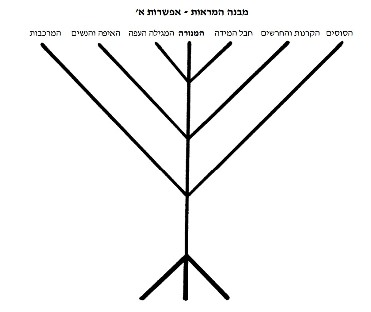Zekharya 4–5 | Zekharya’s Visions - Continued; A Proposed Structure for the Visions
In Chapters 4–5 we continue encountering the visions of Zekharya. Chapter 4 describes a vision of a seven-branched candelabrum with two large olive branches to its right and left. In this prophecy too, Zekharya repeatedly asks the angel to explain the meaning of the vision. Ultimately, the content of the prophecy connects to the leadership of Zerubavel and the idea that the faint redemption will yet grow and flourish.
Chapter 5 presents a series of visions that are difficult to interpret — a flying scroll, a woman sitting inside an epha (a measuring vessel of approximately 25 liters) representing wickedness, and two women carrying the epha and taking it to the land of Babylon.
In the attached article, Rav Yoel Bin-Nun offers an in-depth analysis of the prophecies of Chaggai and Zekharya and their connection to Chanuka. With regard to the sequence of Zekharya’s visions (see especially pp. 7–27 in the file), Rav Yoel suggests that the visions are arranged in a concentric structure in the shape of the menora. Thus, the vision of the horses in Chapter 1 parallels the vision of the chariots in Chapter 6. The vision of the horns and craftsmen (Chapter 2) parallels the visions of the epha and the women (Chapter 5), and in the center lies the vision of the seven-branched candelabrum — which relates to Yehoshua the High Priest and Zerubavel, the governor of Yehuda.
In the horse vision, the horses go out across the land on God’s behalf and find that the entire land is calm and tranquil — except for Jerusalem. In these visions, a cry is heard — “How long will You have no mercy on Jerusalem?” (1:12) — and there is a promise that God will return to Jerusalem and express anger toward the nations. In the visions of the horns and the craftsmen, the nations that exiled Yehuda are mentioned: “those who scattered Yehuda, Israel, and Jerusalem,” and in the visions of the epha and the women, wickedness is carried back to Babylon as part of the process of restoring order to the world and settling accounts with Babylon. The return of wickedness to Babylon completes the command that Israel flee from Babylon and return to Jerusalem (2:10).
At the center are the prophecies to Yehoshua and Zerubavel, which serve as the key to fulfilling all the visions. Rav Yoel suggests that the two olive branches symbolize these two leaders, who are both anointed with oil (see Rashi 4:14). The redemption’s execution depends on dual leadership — a combination of kingship and priesthood. As summed up in the verses at the end of Chapter 6, in the prophecy of the crowns which concludes Zekharya’s visions: “And between them there will be peaceful counsel” (6:13).
For further insights, see the attached article. There, Rav Yoel expands upon and details the structure he proposes for Zekharya’s visions, suggesting several internal substructures, and offering a broader analysis of the prophecy’s details, their integration into the overall structure, and their meaning.



This website is constantly being improved. We would appreciate hearing from you. Questions and comments on the classes are welcome, as is help in tagging, categorizing, and creating brief summaries of the classes. Thank you for being part of the Torat Har Etzion community!